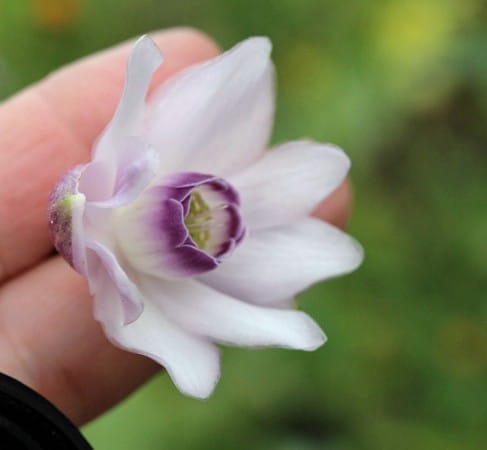
Do you remember the first time you saw a fascinating plant that you’d only read about in magazines, books or online? I bet you do. The first time I saw blue poppies (Meconopsis spp.), they were growing in containers at Bayport Plant Farm in Lunenburg County, N.S. That day is printed in my mind for two reasons — the glory of the blue poppies flowering their little heads off, and that was the day I met two people destined to become my friends, Captain Richard (Dick) Steele, and his daughter, Diana Steele. Both are gone now, but I grow plants in their memory, including Meconopsis, which do well for me despite their diva-like reputation.
Last week, I was at a friend’s garden when I met another exciting and new-to-me plant. Anemonopsis macrophylla is a native of Japan, a member of the buttercup (Ranunculaceae) family, and related to hellebores, anemones, ranunculus and trollius. It’s a monotypic genus, meaning there is only one species in the genus, and so far there don’t seem to be any cultivars. It’s a beautiful plant, similar to anemones, with lovely cut-leaf foliage, above which nodding, waxy flowers appear on tall stems. The flowers are white with deep purple-blue around the centre tube of each bloom, and purple tinting the white on the back of each petal. Anemonopsis is sometimes called false anemone, but I like its genus name well enough that I simply call it by that name. It blooms in late summer, at a time when many other plants are winding down, and the flowers are stunning, so what’s not to love?
Seeing this grow in a Nova Scotia woodland garden made me instantly happy, especially as it was already beginning to bloom so I could see the flowers for myself. Naturally, I then wanted to have it for my own garden. Although my new Wolfville garden is much reduced in size from my previous one, it does keep expanding, and fortunately there is room for expansion. Despite that, I am somewhat cautious about what new plants I drag home, but only somewhat. No large evergreens or giant grasses, but a well-behaved perennial or seven or two dozen? No problem at all.
I asked my friend where she had got hers, expecting to hear that she’d ordered it from somewhere, but my excitement quadrupled to find out she had purchased it from a local nursery. I was at the nursery the next day getting mine. It’s now planted and is happily blooming in the shade bed. When we gardeners want something, we want it now.
Anemonopsis grows to about 30 inches (75 cm) tall and is hardy to Zone 4, but like Meconopsis, it wants particular growing conditions in order to thrive. It likes shaded, moist locations that are rich in organic matter, but have good drainage — winter wet will kill it, the same as it will kill blue poppies. Plant it in the same shade garden conditions with primula, astilbe, ferns and hellebores, which will provide flowers earlier in the season while the Anemonopsis is growing and preparing to put on its show.









